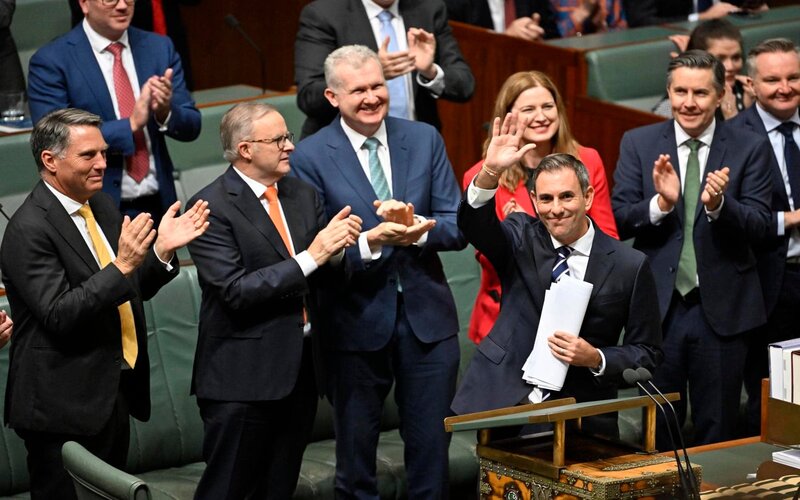Labeled as a responsible budget for uncertain times, Treasurer Jim Chalmers kept the surprises at bay in order to provide cost of living relief, funding across critical services and investments into a stronger economy.
Yet arguably the biggest surprise was the budget returning to surplus for the first time in 15 years, with Dr Chalmers expecting a $4.2 billion surplus for 2022‑23.
“The forecast surplus in 2022‑23 of $4.2 billion (0.2% of GDP) is a dramatic turnaround from the $77.9 billion deficit we inherited from the previous government,” Dr Chalmers said.
That said it's forecast go back to a small deficit of $13.9 billion for 2023-24.
AMP Economists Shane Oliver and Diana Mousina noted that while it may look like ‘rivers of gold’ are flowing to Canberra, it’s really good luck flowing from conservative forecasts regarding jobs, wages, inflation and commodity prices.
“This windfall is estimated to reduce the deficit this financial year by $42 billion compared to last October’s forecast, with carry over to next year before slowing as unemployment rises,” AMP Economists said.
“Some of the windfall has been spent, but 86% of it out to 2026-27 has been saved.
“As a result, the budget is now projected to be in surplus for this year – its first since 2007- 08 - a massive turnaround from the $99 billion deficit projected less than 18 months ago.
“[This marks] the fastest improvement as a share of GDP since the end of World War 2 when the deficit went from 10.5% of GDP in 1944-45 to 0.8% in 1946-47.”
A budget big on health
The government signalled a strong focus on health in the budget, flagging its intent to fund a raft of measures including boosting Medicare and tripling the bulk-bill incentive.
NAB group economists said Australia’s universal health-care system, with primary care at its centre, has long been regarded as among the best in the world.
“But Medicare (now 40 years old), is under growing pressure given the aging population and rise in chronic diseases and life expectancy,” the economists said.
“NAB research suggests around 4 in 10 Australians require ongoing treatment or medication for a medical condition, with over 8 in 10 of these ‘chronic’ - lasting or expected to last 6 months or more.”
With these figures in mind, the boost to Medicare and tripling the bulk-billing incentive will provide more than 11 million Australians greater access to bulk-billed GP visits.
The Royal Australian College of General Practitioners President Dr Nicole Higgins noted the budget is a win for patients.
“Hiking Medicare rebates this year in July and again in November is a good first step in reducing out-of-pocket costs for patients across the country at a time when it’s most needed given increasing cost of living pressures,” Dr Higgins said.
A budget big on cost of living relief
The budget unveiled a $14.6 billion cost of living relief package, tailored to those most vulnerable to provide some much needed relief.
The government aimed to do so in such a way to juggle inflation, with many economists wary that incentives may add fuel to the fire.
AMP economists said while some of the cost-of-living measures will directly help lower measured inflation (by around 0.4%), the new fiscal stimulus next financial year of $12 billion risks boosting demand and adding to inflation.
“But it’s hard to be adamant as overall the budget is taking more out of the economy compared to the projections last October,” AMP economists said.
Further, CPA Australia Senior Manager Business and Investment Policy Gavan Ord said a sugar hit of spending for middle income households may have been politically popular, but could have made inflation worse.
“[The] targeted relief for the most vulnerable, such as JobSeekers, pensioners and single parents is the right approach.
“The government now needs to evolve its thinking from providing support to growing productivity.”
A budget light on tax and reforms
With cost of living front and centre, Director of Tax Communications at H&R Block Mark Chapman noted this was a budget relatively light on tax measures with most of the heavy lifting done on the spending side.
“Increases in JobSeeker for all claimants, a package of rent assistance for those on low incomes, energy bill relief and a huge boost to Medicare will all be welcome,” Mr Chapman said.
“But there was no news about the Morrison government’s Stage 3 tax cuts – which remain legislated to come into effect on 1 July 2024 and which will largely benefit the most wealthy.”
ACOSS CEO Cassandra Goldie said the government is providing an increase of $2.85 a day for people with the least - the Stage 3 tax cuts will deliver $25 a day to people on the highest incomes.
“We have our priorities wrong,” Dr Goldie said.
The tax cuts would deliver someone earning $125,000 less than $43 a week in savings.
This comes as the budget announced an increase to the rate of JobSeeker by an additional $40 a fortnight for those eligible.
More work to be done to alleviate housing woes
There was little by way of direct initiatives towards housing supply in this year’s iteration of the Federal budget, with the government instead unveiling incentives for private sector investors in the build-to-rent (BTR) space with the intent to boost housing stock.
CoreLogic Head of Research Eliza Owen noted the government faces some constraints in providing stimulus to build new housing.
“With a high inflationary environment, constrained construction sector and high net government debt levels, it is understandable that the private sector is being incentivised to provide more housing development,” Ms Owen said.
“However, this provides little clarity around how much the boost to BTR will deliver in the way of affordable housing.
“Direct investment into social housing or the passing of the help-to-buy scheme through parliament would be a step in the right direction for having a more material impact.”
Speaking to Savings.com.au, PRD Chief Economist Dr Asti Mardiasmo said that for a long time powers-that-be have tried to address the housing affordability issue by incentivising the demand side of housing, making it easier to buy a home, but neglected to incentivise the supply side correctly.
“The current incentives for the BTR sector will be welcomed by the demographics of BTR, those being renters,” Dr Mardiasmo said.
“Thus this is a mismatch, as the policy that addresses private demand is designed to increase homeownership; and yet the policy that addresses private supply is designed to create more homes for renters.
“To stimulate private supply can be difficult, for the sole reason that planning strategies, development approvals and so on are within the authority of local government councils. The only thing the Federal government can call upon is greater coordination between all three levels of government.”
On social and affordable housing, the liability cap of the National Housing Finance and Investment Corporation (NHFIC) has been raised by $2 billion to $7.5 billion, to provide more low cost loans to community housing providers.
Dr Mardiasmo said while this initiative is applauded as always the devil is in the detail.
“Increasing the NHFIC cap by $2 billion translates to approximately 7,000 affordable homes, but the real questions are where, when, how and what kind of homes,” she said.
Image by Jim Chalmers via Facebook



 Denise Raward
Denise Raward
 Harry O'Sullivan
Harry O'Sullivan

 Rachel Horan
Rachel Horan
 Harrison Astbury
Harrison Astbury
